Product Manufacturing Secrets
Starting a dropshipping store is one thing. Taking it to the next level, whether that's white-labeling or manufacturing, is a whole other game. As you advance to the next level, many more factors come into play.
In this episode of Start Yours, we pick the brains of one of the world's leading sourcing experts.
Kian Golzari has visited over 500 factories and sourced over 2,500 products for both big brands and small brands. He talks about his sourcing methods and dishes out great advice about how to communicate with manufacturers.
Spoiler alert: It's all about building a long-term relationship.
There's just so much that Kian dives into that this is one episode that you do not want to miss, especially if you're looking to get into white-labeling and manufacturing.
If you're short on time, we have, as usual, a TL;DR version of our chat with Kian. But because this is one episode that's filled with so much value, we highly recommend you set aside the time to listen in. We promise you won't regret it.
- If you can get the best product at the best price from the best manufacturer and offer the most value to your customer, you can supply anyone you want.
- Only when you've spent time in a factory, watching a product in all its different pieces get assembled can you spot inefficiencies.
- There are different factories you can order from based on your customer avatar, who you're supplying, and what you want out of that factory.
- When developing a product from scratch, create a specification sheet that includes all the details of the product and send it to various different factories.
- To be 100 percent confident that you're supplying something valuable to the world, you must have first tested and used it yourself.
- Download WeChat and start building a personal relationship with your manufacturer on there.
- At the end of the day, it's all about support; you have to support your manufacturer and they have to support you.
- To get a low MOQ, order from a smaller factory or during low season.
- When developing products, launch when it's 80 percent ready and work on the remaining 20 percent after.
Start Yoursis a podcast about ecommerce, dropshipping, and all things launching a business.
Join us as we meet entrepreneurs who have gone through the triumphs and headaches of running an online store, and learn how they managed to survive and thrive.



First Taste of Manufacturing
Aleisha:Kian,感谢你加入我们开始哟urs. I am so excited to speak with you because I have so many questions to ask you about manufacturing, about dealing with people that make things overseas. I think a lot of people get quiteoverwhelmedwith this process, so thank you so much for coming on the show.
Kian:Oh, it's an absolute pleasure. Thanks so much for having me, and it's great to connect with your audience, and looking forward to jumping into it.
Aleisha:Yeah. Well, as I said, you've got a lot of strings to your bow. Can you tell us how you started? ‘Cause it's quite a niche sort of gig you've got going. And yeah, tell me how it sort of went about and where you are at now.
Kian:Sure. I mean, I've been super lucky. I've been living and working in China for more than ten years. I went for the first time at the beginning of 2010. and I was super lucky because I worked for a family business, we have a camping and outdoor brand.
So when I graduated university, my dad was like, "Oh, hey, do you wanna go to China and do you wanna figure out the production site, and do you wanna run the buying department, essentially, of our business?” And we're like a medium-sized business, so I was like, "Yeah, absolutely."
So I went to China for the first time, was supposed to stay for two weeks, ended up staying for three months and then went back there to set up an office, moved there, lived there for a few years, and really just figured out, “Okay, this is my game, this is my passion, this is what I love,” and I started going to factories.
In the last ten years, I've been to more than 500 different factories and developed over 2500 products.
And I just got this obsession with, alright, learning how products are made, working with different cultures, working with different factories, 'cause essentiallymaking products is solving problems.
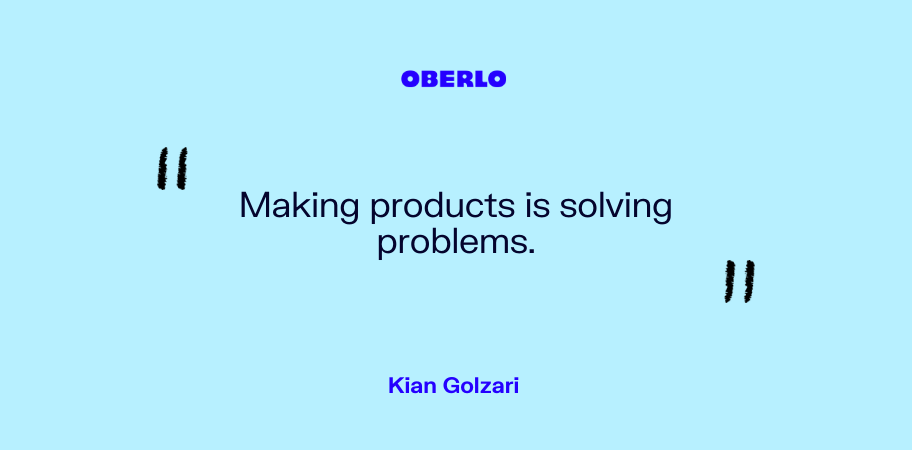
Aleisha:Yeah.
Kian:And for me, it was just so fun to learn the manufacturing process, improve these things, and then as a result, I mean, as I've graduated from making products from my family business to manufacturing for the London 2012 Olympics, then manufacturing for the United Nations, and then ministry of defense, and then big-box retailers in the UK, Europe, and the USA, then helping Amazon private label sellers and then working with the NBA.
And this is such a wide variety of customers, like to manufacture for the military, but then manufacture for Amazon brands. And the common denominator is, if you can get the best product at the best price from the best manufacturer and offer the most value to your customer, you can supply anyone you want.
And for me, living and working in China for that length of time, that was just what I became good at. And it's crazy because the whole time I was there by myself, it was very lonely. But in the last sort of two, three years,ecommercehas exploded.
There are all these communities, there are all these events, there are all these Facebook groups, and no one really knew much about sourcing, 'cause everyone's just kinda trained, "Alright, go to Alibaba, type in what you want, order it, and it arrives."
But for me, I've just been going through the ins and outs of the products for so long that I was like, “Well, there are a lot of things that are not being talked about here,” so I just started to speak on stages, started a YouTube channel, and all that sort of stuff. And it's been such a fun journey, to be honest, and I'm just so grateful and so happy to be here that I can share some stories as well.
Aleisha:Oh, it's so great, and it is such a good story. And I love that you are like way ahead of the game when it came to being actually on the ground in China as well 'cause I think there are a lot of people that you research and especially in our sort of industry that talk the talk, but don't walk the walk, and haven't been there and had those relationships, as you said, with all of these manufacturers.
It really interested me reading about your bio. And thinking about products and where things come from, there are a couple of good Netflix series. There's one called The Factory that I really got into, and I love when you watch...
Kian:I love that one.
Aleisha:Yeah, it's great. It's so interesting. But it's also like, oh my gosh, this is what goes into making a thing, and I think sometimes we really forget the process behind items that we use every day and how things have been developed. And that must be eye-opening for you to go and actually physically see this stuff go down, and the work and all the intricacies that go into making something.
Follow Kian's Alibaba Tutorial
The Importance of Having Eyes on the Ground
Kian:Can I tell you a cool story about that?
Aleisha:Yes, please.
Kian:So basically, my favorite product to develop is a backpack, right, because I feel that whenever you see someone wearing a backpack, I feel that like, “Okay, I can tell what type of person they are,” because, you know, backpacks are so intricate, you know, so many different styles you can have.
And it's by far my favorite product to develop because there are so many different ways you can customize it.
Now, before I ever went to a factory, I always thought of a backpack as just like one unit, one piece on a shelf, right? But then when I went into a factory for backpacks, it was the first factory I ever went to, I saw a backpack in like 30 different pieces; I saw the shoulder straps, the foam that goes in the shoulder straps, the zipper pullers, the buckles, the webbing, the coating, the inside lining and then I saw it all come together, and I'm like, "This is crazy."
Because normally, I just saw it as like one unit, and now I saw it as like 30 different units, and it's almost like you can now think in 3D. So if you're like, "Okay, I've got a $15 product, and I need to get it to a $12 product, here are three things I can change."
Or if I need to improve the quality of the product, let me upgrade the zips or let me upgrade the fabrics. And it's like you can only think that way once you've spent time in a factory when you see a product in all its different pieces and it gets assembled, and then that way, you can also spot any inefficiencies.
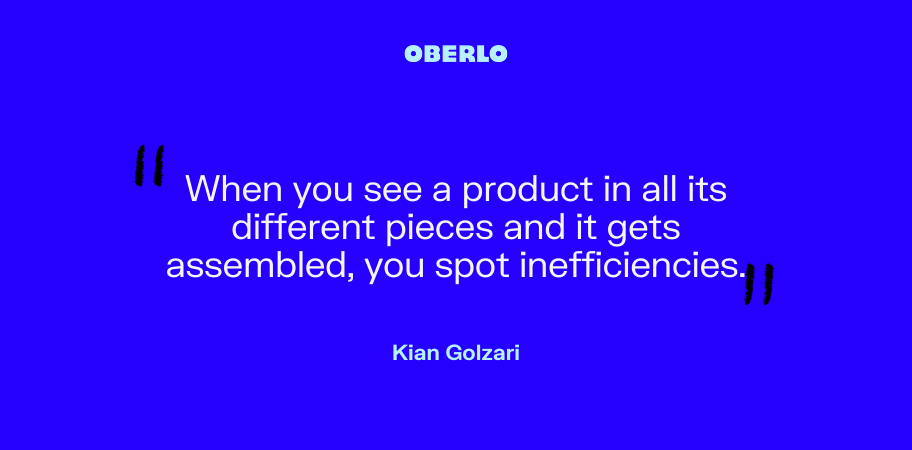
You might see, “Okay, well, on this sewing machine, this part is taking quite a long time. But hey, it's because we requested this curved stitching, whereas if we just did like a right-angle stitch, it would be a lot faster, there'd be fewer mistakes because it's faster, less labor cost,” and it's just the things like that.
Even like another thing, right, so fabrics are cut on 1.5-meter rolls and let's say your backpack, its width is 23 centimeters, there's gonna be wasted fabric on the end. And when I saw all the fabrics being cut, I said to the factory, "What do you do with that wasted fabric?" And they were like, "Oh nothing, we just throw it out."
I was like, "Well, we also make wallets, which are also that size, which is that material, like 600D polyester. If I get you a wallet sample, can you make this?" And they're like, "Yeah, sure." So I got a sample, sent it to them, they constructed it, then they started making wallets with the wasted material that they were throwing out.
Aleisha:Amazing.
Kian:So I never paid for material for the order. And this sort of thing you would never know or never see unless you have eyes inside of a factory. So this is why my mind was blown, and this is why I spent so much time there just learning how products were made.
The Complexities of Developing a Product
Aleisha:I love this and I love your thought process. But I also love that... Yeah, I hope people listening now and watching will be able to actually think when they next look at something, and I'm just looking around my house now going, what have I got here to think about that deconstruction and think about what goes into actually forming a physical product?
I really am interested in you saying about the different levels of quality and what theprofit marginsare. And I suppose a huge part of your job is helping clients come up with the correct balance, I suppose. When people come to you and say, "Hey... " Let's say backpacks, 'cause I know that's something you've worked with quite a lot, and I think backpacks are great, a great sort of sample to talk about.
If I came to you and I said, "I've got this idea for a backpack, I want it to retail at $50." How does that then transpose to you working with your vast network of manufacturers and also thinking about design?
Is it basically going, "I want it to be Aleisha's backpack and it's gonna be my brand that I've just made up," or is it coming to you with a sketch? Like how complicated does it have to be to make something?
Kian:Yeah, there's such a wide spectrum. There are so many different ways you can develop a product and that's a great question. So first of all, within the backpack, like I've got maybe 20 different backpack factories that I work with; some specialize in travel bags, fashion bags, military bags, hiking bags.
And then within those, some are specialized in low-priced products, but in high quantities. Some are very specialized equipment, specialized workmanship, but maybe a low volume, the type of bag that would be capable of climbing like Mount Everest. It needs to be very complicated, intricate, like the proper compartments for everything, top materials, against a $5 school bag.So there are different factories you know to place business to based on who your customer avatar is, who you're supplying, and then what you want out of that factory.
But in terms of the actual development of it, you can have this idea in your head and then you can start to sketch it. You can show images from other brands that you've seen, you can get little fabric cut-outs and you can put what's almost like a mood board on the wall, like, "Okay, I want this type of fabric, I want this sustainable material that comes from recycled plastic bottles that have been taken from the ocean."
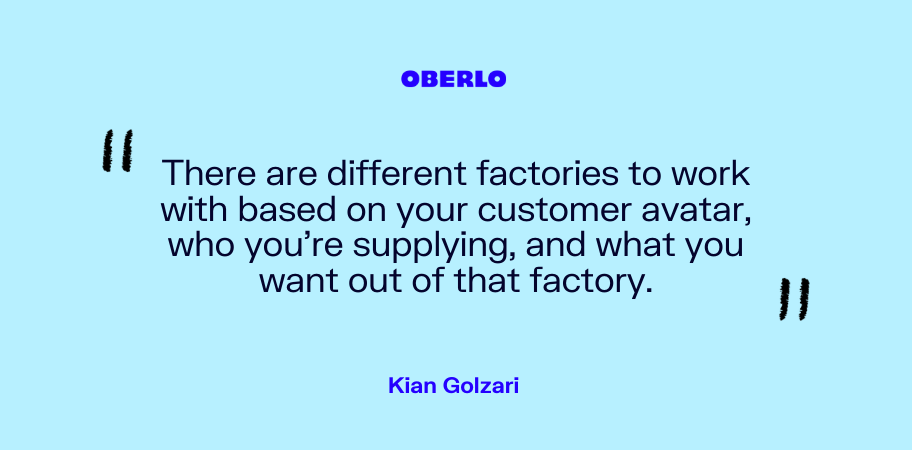
Create a Specification Sheet
You can literally just take any components of a product that you want and create what I call a specification sheet. And your spec sheet should be like, all the details of this product; it should be the dimensions and materials, is there a waterproof coating, anything like that, something that could be given to a five-year-old that they can understand. And then so when the factory sees it, they're like, "Okay, I know exactly what I need to do with this," and they start to price it up.
Now, why that spec sheet is so important is because you have to give all the factories the same information.
So I don't just give it to one factory. I'm giving it to maybe four or five different factories and we'll see what the price range is. Some might be $8, $9, $10, $9.50, so you can kind of get an idea of the range and what's the fair price to pay for this product.
Just so if someone says, "Alright, this bag is like $6," and you're like, "Okay, it's too good to be true. They must not have understood all the materials or they're gonna take a shortcut later on," and if someone's like $15, you're like, "Well, they know, they're just trying to add a crazy margin."
So once you have an idea of, okay, what's the price range and who is the supplier that you wanna work with, then I would just get samples of each and everyone, and it's so, so important to test the samples, which you order as well because I see far too many people who don't even test the products that they're ordering.
Like they buy it from one website, Alibaba, and they sell it on another website like Amazon or their ownShopify store, but they never actually come into contact with their own product. And something I'm big on is being a product practitioner; are you using and testing the product yourself?
So for example, when I'm just doing my family business and all the camping and outdoor products, if I'm developing a sleeping bag and a tent, I'm taking it to the hills and I'm sleeping in it. If I'm developing a backpack, I'm hiking in it because I need to know when it's freezing and I need the bottle of water, is the water bottle compartment close enough to my hip that I can just grab it, or do I need to fumble around in my bag? Like, are the zippers... Do they still work when it's freezing cold?
Stuff like that you only know by using it and testing it yourself because you are your own toughest critic.
即使是像咖啡一样简单的事情ug, fill it up with hot water five times, make sure the handle doesn't fall off, make sure the paint doesn't melt, chip, or anything like that. So you are 100 percent confident that you're supplying something to the world of value that you know you've tested and used yourself.
And then the other side of the spectrum is another concept that I call imitate and innovate. So you take a concept that already works, you might see a sample in a store or from another website, and you're like, "Okay, perfect. I love this product, I like everything about it, but I just want to maybe change it to my color, or make the size a little bit bigger, or change the function for kids rather than adults," or something like that.
And that's a lot easier and quicker because you can send the product to a factory, and then they can just make a small change. Butwhenever you have an idea from scratch, there's a lot of development involved in that.But that's also great 'cause you've got something unique that you're bringing to market that you know that no one else has got for now.
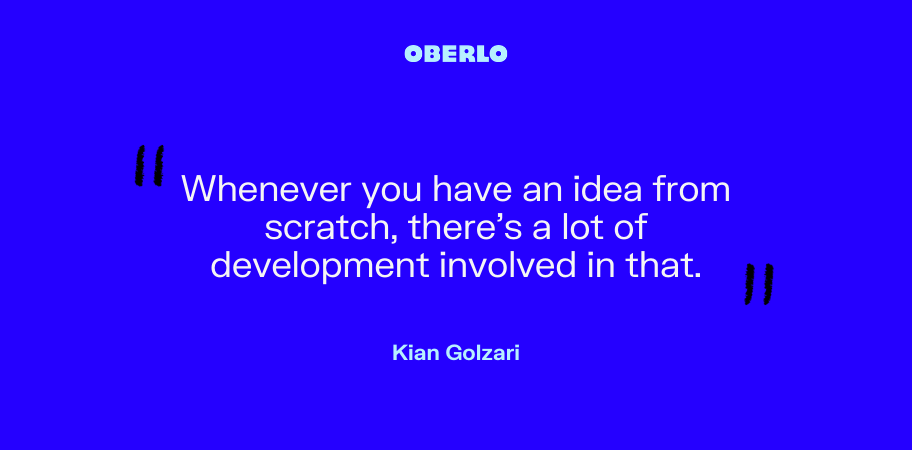
Aleisha:That's brilliant, and I'm so glad you mentioned brand integrity and testing products 'cause I think a lot of people, especially those who are new todropshipping, see it as a shortcut to, as you said, just link the store, off to the races.
然后他们开始变得很多customer complaints, they don't know what actually is being sent from a manufacturer direct to the customer, and that's where people can get really dented by the system and the process, when actually, as you said, a really simple way to solve that problem is to not only sample the products, but as we're gonna talk about soon as well, is have a connection with the manufacturer, so if something goes wrong, you actually know who to speak with.
'Cause I think a lot of people then struggle 'cause they're like, "Oh, we've just connected the app, and nothing's working and people are getting angry at me." And it's like, "Ugh," where you could actually solve that problem quite quickly.
So let's move on to that, but I really wanna come back to also about white-labeling later in the episode as well 'cause I know a lot of our listeners are doing well with a niche product that they've started to sell, and then, later on, they want to make the product themselves, so I'd love to hit that.
But before we do, let's talk a little bit about connecting with manufacturers, and how we should be focusing on communication and making sure that they know who we are and we know who they are, and we know that the relationship's gonna work.
How do we go about hooking up with people to make sure our businesses are gonna thrive?
Connecting With Manufacturers
Kian:So, it's super, super important, and I'm so glad you brought it up because, at the end of the day, people buy from people. The same way your customer buys from your store, they wanna know who's the founder, what's their origin story, why should I be buying from this brand? And it's the same way when you work for manufacturers as well.
In all my content, I stress the importance of the relationship, and the relationship is important becausethe better relationship that you have, the better price that you're gonna get, the faster lead times that you're gonna get;you're gonna pass the inspections better, they're gonna offer you new products, and it's just like it's amazing what can come from a great relationship with the manufacturer.
Now, a lot of people have been trained that when you inquire about a product, you go on Alibaba, you type in, “Okay, what's your best price, what's your minimum quantity, what's your fastest lead time,” whereas, I hate that approach because, if you think about it, right, these manufacturers are getting messages maybe like 50 times a week, 100 times a week from loads of different people who are being like, "Okay, how much is this massage gun?" And if you're on the other end of that laptop or computer, you're like, "Oh, another price inquiry".
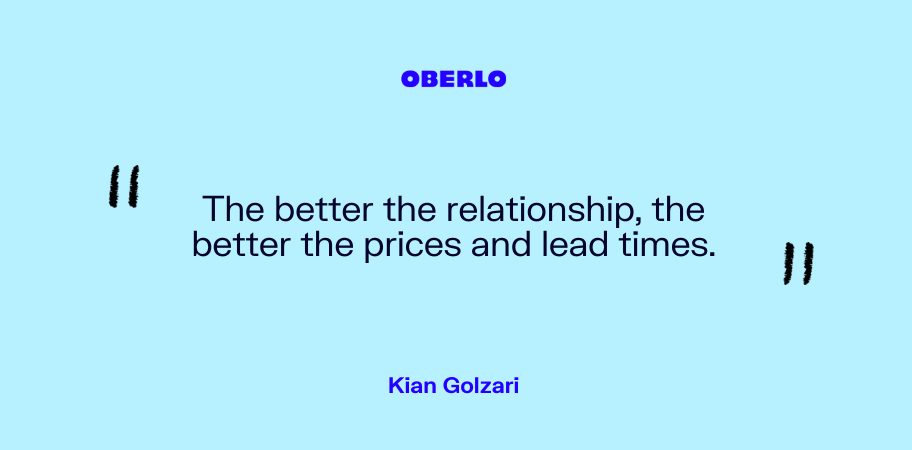
But imagine if you have a passion for, let's say, yoga. If you reach out to a supplier and you say, "Hey, I really like your products, I've browsed your website, I've browsed your Alibaba listing, you seem to have a high focus on quality, I can see you have a lot of certificates, I can see that you supply the North American market as well, which is also the market that we're supplying, so I feel like you're gonna be a great partner to align with for the long term."
And that's a very important keyword to use as well, like "partner" and "long term" because the supplier is not thinking like, "Okay. How much money am I gonna make from this order?" They're thinking, "How much money am I gonna make from this customer over the next three, five, ten years?"So for that reason, you wanna stress the words "partnership," "long term," and “we're gonna work together.”
But then I think it's very important to state your leverage as well because in your first order, you might not place a large order quantity because you just wanna try out the product and try out the manufacturer. But what I would say is, "Okay, I've been a yoga instructor for 15 years. I have my own yoga studio, I know all the top influencers within the yoga space, I've got so many great ideas to develop yoga products."
And the supplier's thinking, "Oh, this is a customer we want; this is someone who's very knowledgeable about the products, this is someone who's gonna keep us right as well, this is someone whose vision we believe in, we want to support them."
Because at the end of the day, it's all about support; you have to support your manufacturer and they have to support you.
I always say, “I'm not the customer and you're not my supplier. We are working in partnership together. What works for me is what works for you. If I get a great quality product at a great price, I'm gonna make a lot of sales. The more sales I get, the more orders for you,” whereas if you don't build and if you don't focus on that relationship, it's just a transaction like you would order from a website.
But you have to work in partnership together, and you learn so much from them. And the other thing is that a lot of my manufacturers that I work with have become like my best friends. I've been to their weddings in China, they've come to Scotland to visit me on holiday.
And one of my suppliers actually asked me to name his child as well. So that's how close we are.
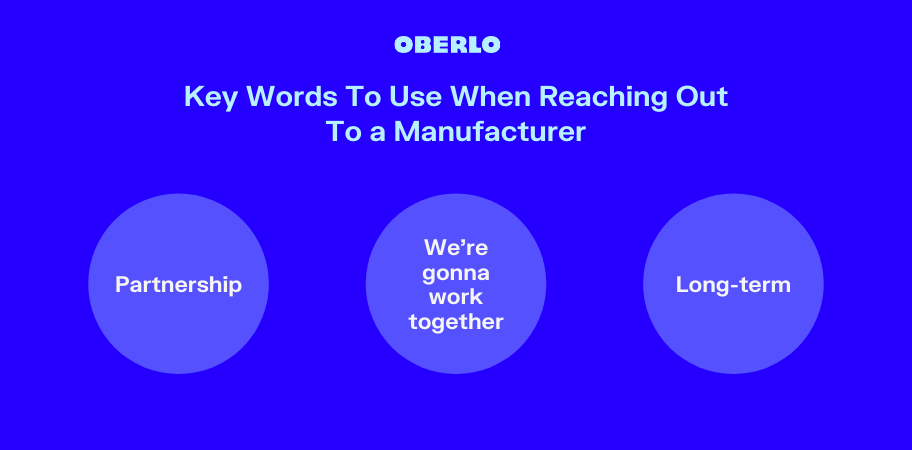
Aleisha:Wow. That's great.
Get on WeChat
Kian:Yeah. And if you think about it, would the person who's asked you to name their child really screw you on the price? Or take a shortcut on your production? But no, and that's the relationships that we have.
同样的我们,作为消费者,长到爱brands that we purchase from, well, it's the same way with your manufacturers as well; you grow to love doing business with them and hanging out with them, you just wanna see each other win, and that's just something that's not really talked about but it's so important.
But one quick tip that I can give to the listeners is, like, okay, everyone's like, "Well, how would you build up this relationship?" And I always say, okay, the best thing to do is get on a plane, go to China, go to your factory, meet your manufacturer, go out for dinner, get drunk together, that's the best and quickest way.
Yeah, it's a lot of fun, but obviously, with the situation we're in that's really challenging. But every manufacturer has got an app on their phone called WeChat, andWeChatis like the Chinese WhatsApp or Facebook Messenger, that's just what they use for their communication and for sharing photos and stuff like that.
So just ask your manufacturer: "What's your WeChat?"
并保持所有重要业务主题哟乐鱼app官方在线ur price, your delivery date, and all that sort of stuff to email.But add them on WeChat, and say like, "Hey, what did you get up to over the weekend? Here's a photo of me and my mates, we just played football, I'm great, what did you get up over the weekend?"
And also now we have Chinese New year approaching. Chinese New Year is like the 12th of February, where a lot of people are gonna go back to their hometown and have a long holiday, you're like, "Hey, what's the plans for Chinese New Year? Are you gonna see your family? What are you guys up to? Send me some pictures, send me some videos."
And that's a way to quickly build the relationship, have some video calls without even having to go to China, and if you do that, look at the service that you're gonna get in 2021, once you build that relationship.
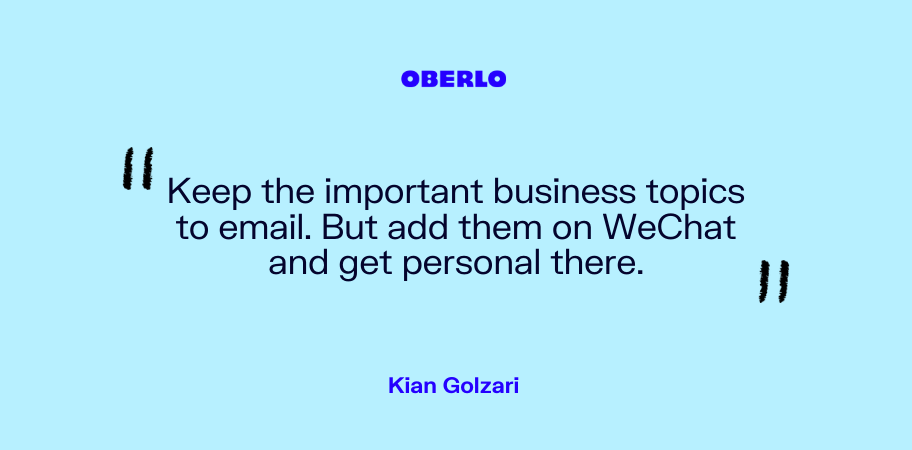
Moving Into White-Labeling
Aleisha:Oh, it's so valuable, Kian, I'm so glad you said that because I think a lot of people see manufacturers as faceless, nameless, just workers, when, as you said, we don't wanna be treated that way, and if you develop trust and build up that sort of, as you said, long-term relationship, you are far going to exceed expectations from both sides of the relationship rather than just messaging through an app.
That's great. So if you were going to move into the white-labeling world and let's... I suppose we should describe what white-labeling is for people. This is a new sort of phrase. Can you tell us what that would mean to you?
Kian:Sure. Essentially, white-labeling is taking a product, a concept that already works, and just adding yourbrand logoon to either the product or the packaging, and just basically sending it out as is. And I guess the reverse of that is actually developing something yourself and coming up with your own ideas.
So a lot of people find the speed to market just by white-labeling and that's how they learn the ecommerce game, by starting out that way.
But then a lot of people graduate from that and are like, "Okay, I know how to make money now, I know how ecommerce works, now I want to go ahead and build a product of value that I believe strongly in," if you know what I mean.
Aleisha:Yeah, and it is... I think it's really wise of you saying it's a good transitional period if you are maybe dipping a toe into the dropshipping world. I know we've had guests on this show who've said, “I found that one thing.”
It could be like the iPod... Everyone's talking about the air pod cases, which, obviously, they're a huge thing now, but going from that, it would be, as you said, them saying, alright, "I wanna change the shape of the case, or I wanna add something extra."
So what is the next stage? So then if we're working with someone like you, we would approach you to then do the negotiations, or how does that sort of system and process work when we level up from going from white-labeling to then working with the big guns?
Factors To Consider When White-Labeling
Kian:Sure, a great question. I would say you have to ask yourself, first of all, am I branding, or am I selling? Because I think there's a big difference of... A lot of people sell products to make money and they don't care what they sell, they might sell dog nail clippers, or they might want to build a brand around their passion. And something that they really wanna add value to the world, and that's their passion.
So the first thing I'd ask myself is, okay, am I selling or am I branding?
And then, am I building a business for the short term, or for the long term? Am I just in the game to make some quick cash and I don't care what I sell, or am I just wanting to build something for the future?
'Cause I think if you have a short-term vision or a long-term vision for your business, it's gonna greatly affect the way you build relationships, and the way you sell products, and the way you build websites, and build brands and do your social media and things like that.
But the key thing for me is I always... And when you transition from white-labeling into building a brand for yourself, is that I think the biggest strength ofbrandingis that branding allows you to build a community, and once we have a community, you have control over your own audience, and it's an audience that you've built.
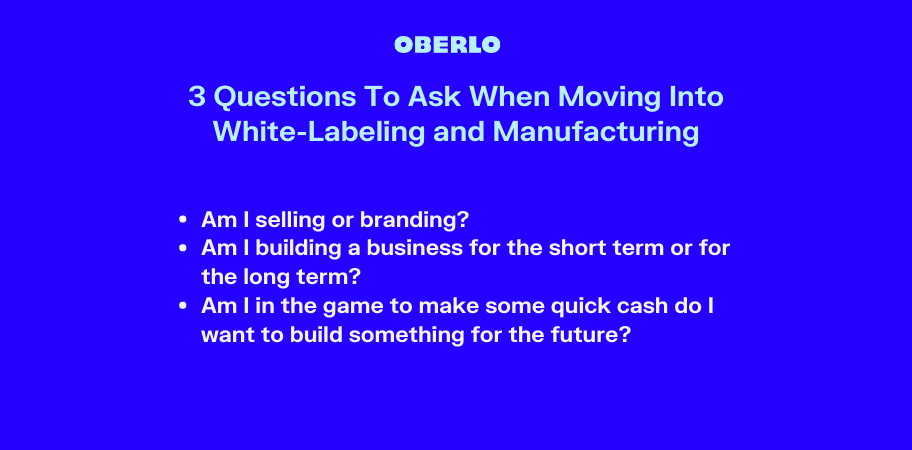
And essentially, imagine the amount of money that you have to spend onFacebook adsand Instagram ads, and spending on influencers and stuff like that, and people to promote your products, paying for pay-per-click on Amazon, whereas if you just built your own community based on a brand that adds value, you've built your own audience. Imagine having your own Facebook group of like 10,000 raving fans, when you wanna launch a new product, you just launch in your own Facebook group.
But for me... Okay, people ask, "Alright, how do you start a brand then?"I would say branding starts with core values.What, as a company, do you believe in? What are the core values of your company? And you can Google any big company that we all know, like Coca-Cola, Apple, Google, and just see what their core values are.
But for me, my core values, and it's for myself and my business, are loyalty, harmony, high performance, extreme ownership, and constant improvement.
And those things, those core values that when... It's even not only for the products you make, and the people you work with but also the people that you hire. And when you explain your core values to someone that you're hiring, you want them to say, "Hell yeah, I'm home. This is the place for me,” or, "This is not for me."
Because you don't want, "Great... " You want someone to be like, "Alright, I'm with it. I get these people and I get what they're about, and I wanna join," or you don't want those people at all. And then in terms of going from there, is like how do you build the products for your brand, for your community, for your audience? And I thinkit's very important to have a customer avatar, atarget audience,知道是谁is the person you're selling to.
For example, the average consumer who purchases your product, how old are they? Where do they hang out? What sort of salary do they have? How many holidays do they go in a year? How much disposable income do they have? And once you give that avatar a name, and know who they are, then you can understand how to communicate with someone, how to speak their language.
And you speak their language through the products and the names that you give your products.
So for example, if you have a fitness brand for young females, but okay, young females also like to go out on a Saturday night with their friends and they like to drink cocktails, alright, what's your favorite cocktail? I don't know, Long Island Iced Tea, Sex On The Beach, all those sorts of things.
And then you have, let's say you're bringing out a protein shake, you name your protein shake flavors after the drinks that they have on a Saturday night. So that when a girl goes to buy the protein shake, and she sees one called Long Island Iced Tea, they're like, "Okay, this brand gets me, they understand me.”
And it's like, you almost want some people to see that and be like, "That's disgusting, I would never buy that brand." But then you want someone else to pick it up and be like, "Hell yeah, they get me." And that's building community, and that's going super niche, because even in a category like protein shakes, having a small niche, which is 0.5 percent, it's still a massive market.
Aleisha:It's huge.
Kian:But you're really identifying who you wanna be selling to, and then that's just what helps you develop good products as well. That's kind of like the graduation I've got in my mind from going from white-labeling to then branding, but then...
Sorry, that's more focused on the selling side, but I guess to talk about the manufacturing side of things as well, is that in the times that we're in, I would always... If we weren't in this pandemic, I would obviously go to theCanton Fairin China. That's the biggest import-export exhibition in the world, which happens twice a year. It's got over 26,000 exhibitors there. You can literally find any product you want.
But the suppliers which attend the Canton Fair don't necessarily post their products online on platforms like Alibaba and things like that just because they are so good at what they do that their production lines are always full. They have the biggest companies that they're manufacturing for that they don't need to list the products online 'cause they're not looking for more sales.
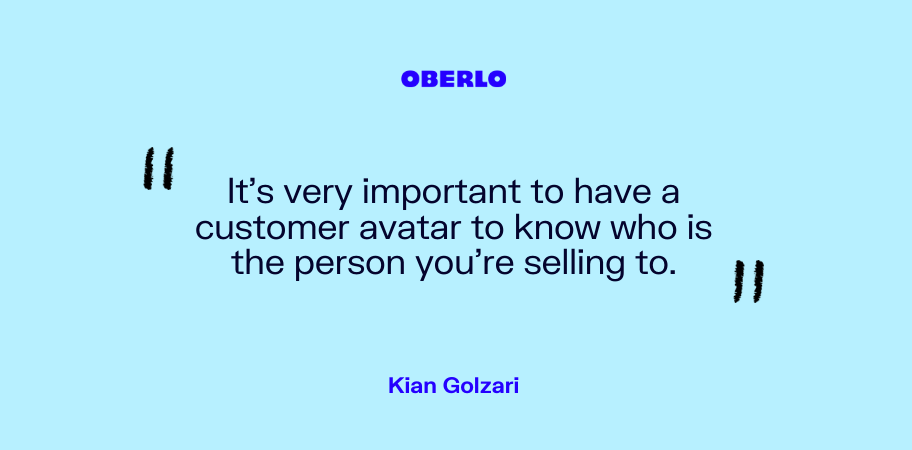
Aleisha:Amazing.
Kian:But in these times... And that's where I've always gone. I've gone to 20 Canton Fairs over the last ten years. And again, I can see the opportunity to build that face-to-face relationship with loads of companies in the space of a week and then go and visit their factories afterward.
But unfortunately, we can't do that at the moment, so we have to use... I would say Alibaba is the best website at the moment in terms of the most user-friendly. And the thing with Alibaba is there are some great suppliers there, but there are also some junk suppliers there as well, like some suppliers who'd just emerged on the platform, who'd try and make a margin on your order, but they really have no clue what they're doing. So I've got a process with which I can find the best suppliers on Alibaba, which I'd love to share.
Aleisha:Yeah, we would love to see it.
Ways To Get the Minimum Order Quantity as a Dropshipper
Kian:So yeah, I think using Alibaba in the right way, which I'll demonstrate later on, is the best way to graduate from that sort of dropshipping model to then communicating with the manufacturers.
But then once we open up that communication, as we kinda talked about earlier, in terms of the relationship building, you wanna open with, "Alright, this is my passion. This is how long I've been in the industry. I know all theinfluencers."
You never wanna say, "Look, I'm a complete beginner. This is my first order," because they're never quite interested.But if you show your leverage in other ways in terms of how knowledgeable you are in this space and about these products and the value you can bring to them, then that's powerful as well.
But the question I always get is, "Okay, cool. I found this great manufacturer. The minimum order quantity for these products, it's like a thousand pieces. But you know, dropshipping, I could order one or two at a time. How do I go about and order like a thousand pieces?"
这里的关键是获得低最低订购量泉tity (MOQ).
为了得到一个低MOQ,正如我们之前所讨论的,哟u wanna show your leverage, your power, your strength, like what your assets are, so they have the vision of, "Okay, this is a customer that I want to support." And I always say... A quick hack to get around this is, I always say like my first order is the trial order.
Aleisha:Sure.
Kian:And I'm doing like the air quotes.
Aleisha:Yeah.
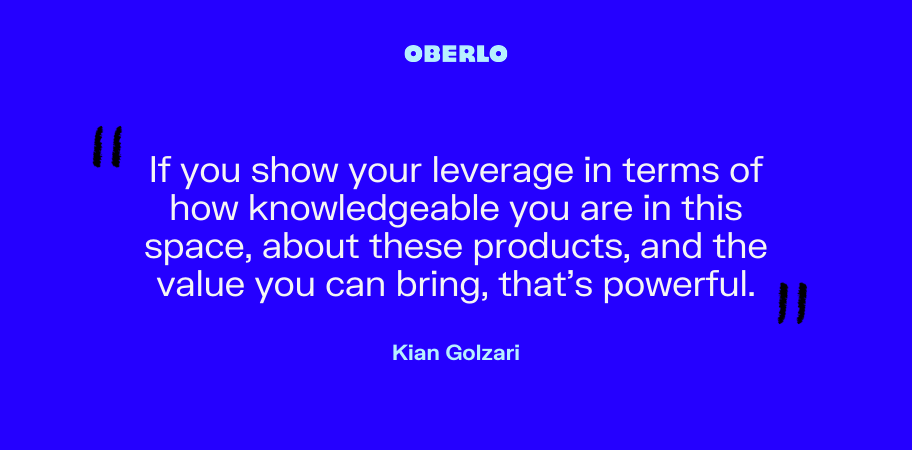
Kian:The first order is always the trial order, and that's just to make sure that your production is fine, that you pass the inspection, that you deliver on time, that you pass through the customs clearance no problem, that the goods arrive in the US or the UK, wherever, not damaged. And once you pass that trial order, we will place an immediate order for a much larger order.
So you're kind of dangling the carrot to say, "Look, if you pass this test if you knock out these 300 pieces and you do a good job, then we're gonna come back and we're gonna place the MOQ."
And that's kind of like... And because you've explained your vision and your idea for the brand, they're like, "Okay, cool."
And as I said, they're not thinking about how much money we can make from this order, they're thinking about how much money we can make from this customer over the next three, five, ten years. So you've kinda validated to them, alright, this is someone I wanna work with. Let me just do what they want. Let me give them this low MOQ.
And then aside from that as well, something I always like to ask your manufacturer is, “What materials are you holding in stock?” Because there are quite a lot of manufacturers which hold on to the stock of materials in their warehouse, either for themselves or for their other customers, and so they've always got access to materials for their sample rooms or for small orders and things like that.
And also at the start of COVID in February, March, when it first broke out, there were a lot of canceled orders. So there were a lot of manufacturers who were just sitting on stock or materials from other people's orders which were canceled.
So if you ask them like, “What materials have you got in stock and can we use your stock material and can you show us what you've got,” well, you might have wanted a red fabric or something, but now you'll put up with like the orange 'cause that's what they have in stock. That's a way of like, "Okay, we'll just take those 200 pieces or 100 pieces of what you have in stock," and they're happy to get rid of that out of their warehouse. So that's another way that you can get a low minimum order quantity.
最后我想说的事情是你know, when I do a demonstration on Alibaba, when you switch your search from products to suppliers, on the left side, it tells you the number of workers they have in that factory, and you can select the factories which have got like zero to 50 workers, 50 to 250, and then like 1,000 plus or whatever.
Now,if you want a low MOQ, you're much more likely to get it from a smaller factorybecause they're also quite nimble and they have a few employees, and maybe they also want to grow with you. But if you're talking to a factory which has got over 1,000 employees and you're saying, "Yeah, I just want 100 pieces," they're like, "No way," because they've got such strict systems and processes in place that they can't just change their production schedule for you.But a much smaller factory could.
所以阿里巴巴给你一个好主意,visual understanding of how many workers they have, and then they're more likely to sort of drop that MOQ for you.
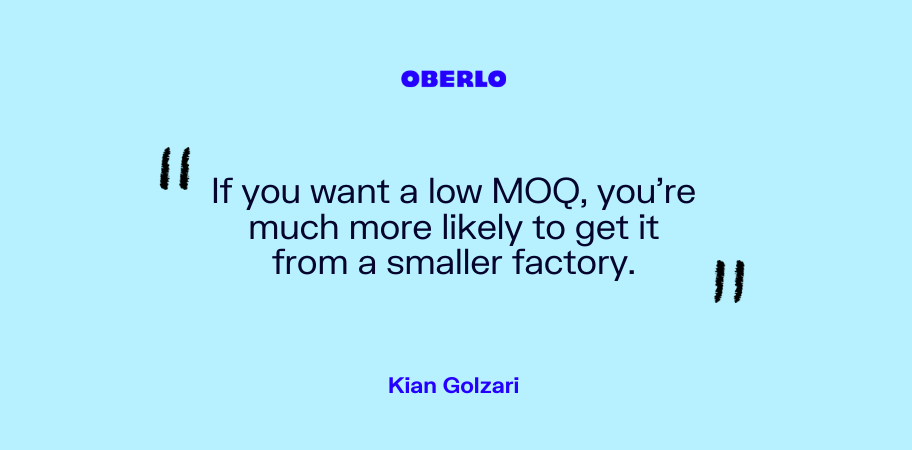
It’s Also About the “When”
Aleisha:That's an excellent tip. And so we are going to... Kian's very, very generously offered to do a bit of a screen-share video for us. So we are gonna share that with our blog that we put up with each episode. So if you go tooberlo.com/podcast, this is episode number 60, you will find that video.
We'll also share it on ourOberlo YouTubeas well so you can go and follow all these amazing tips, 'cause I think it's such valuable information you've just given. Like you just dropped huge, I wanna say, value bombs, 'cause that sounds really daggy, as we'd say in Australia, but that was very, very good information.
Because I think a lot of people, it can feel overwhelming if you are just scrolling through Alibaba... As you said, there are thousands of manufacturers, some people putting up certificates, and you're like, "Are these real? I could have made these PDFs myself. I don't know."
然后还评级,它能感觉到有点sketchy and it's hard to just really be able to sort of home in on what you should be looking for when it comes to quality manufacturers. But also, as you said, why would people waste their time, air quotes as well, with minimum orders, if they can get a 100,000 order, they're not gonna waste their time with us little folks yet until we build ourselves up, so that's fantastic.
Kian:I can't wait to show you this video 'cause I've basically got these filters and processes for showing you the best way to identify the real factories, the certificates, how many years they've been in business, what other brands they supply, all this sort of stuff that will just literally pair you immediately with the best factories.
And it's so good that you mentioned that as well because I've got a YouTube channel and one of the last episodes which I posted was last time I went to China, November last year, I took my camera with me and I interviewed the Chinese factory boss, and I wanted people... 'Cause I talk a lot about sourcing from China, but you're just taking my word for it.
And I wanted to interview a factory boss that I've worked with for a long time and ask him all the questions that ecommerce sellers want to know about, and it's coming straight from the horse's mouth if you know what I mean.
And the guy's name's Eddie, he's an amazing guy, and I said to Eddie, "What's the biggest order you've ever received?" And he said in terms of units, it was 800,000 units and it was a few million dollars, and then he was saying but that type of order is no fun because there are a lot of risks. If there's a problem, it's a big issue.
And I was like, "Okay, and what's the lowest order you would accept from a new customer?" And he said, "Probably around 500 pieces, if we believe in the vision of the customer." And then we broke it down, and it's like, so a manufacturer who takes an order for millions for 800,000 units is also willing to take one for 500 pieces if he believes in the growth of the customer.
Because remember, when I was placing my first order 10 years ago, I was also quite small. But I've grown over this time, and it's because the manufacturers had belief in me. And then I was saying, "Well, look, how can I squeeze in my order of 500 pieces to a factory which is doing such big volumes?"
And he said, "It's workable in the low season," and that every factory has got a high season and a low season, depending on what type of products they're producing and when they'll be in demand around the world.
But let's say, for example, you're doing, I don't know, ski poles or winter gloves, you know that it's in demand in the wintertime, so six months prior to that, or nine months prior to that is when your factory's not so busy because the production's not required.
So that is their low season, and in their low season, they find it difficult to keep all the workers in their factory because there's not enough work for them to do. So that is a time where you're gonna get really low MOQs, and you're gonna get really low prices because they just want orders to give to the workers.
So in that interview, we broke down like, "Okay, when is the right... " Because it's not only the right factory to approach and the right questions to ask, but when is the right time to place your orders, and things like that, and this is how you can really benefit from...
And these are all the things that make a big difference when everyone's selling similar products at a similar price.
But if you can benefit from these small little margins, and then those all compound, and then you can have... This is what it takes to... Yeah, you know. I could go on for ages.
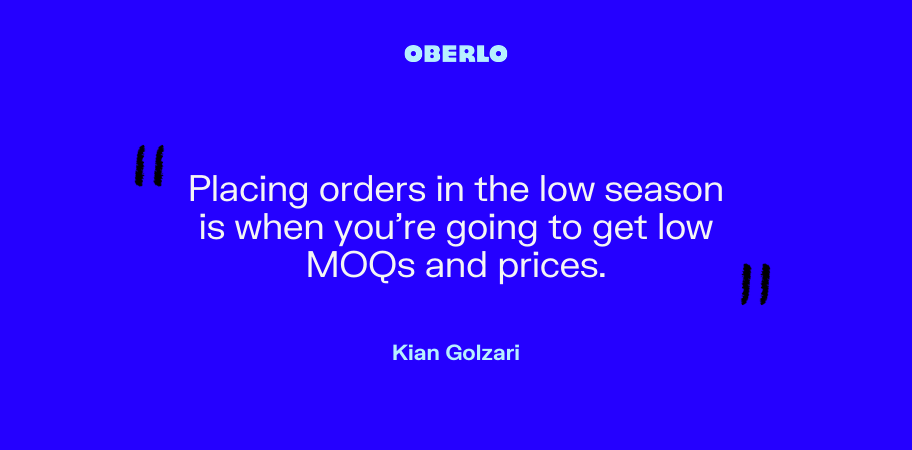
Launch at 80 Percent
Aleisha:No, I love this, and now I'm just like, "Oh, this is near the end of the interview, and I've got like ten more questions you've just given me now." I wanna just quickly jump in 'cause I hope this is okay just to keep you for another couple of minutes.
But talking about seasonality, it's such an interesting part of it as well, and something I think people underestimate when it comes to the timeline of manufacturing as well because it's not like you can just get on WeChat or get on Alibaba or call them and say, "Hey, we need 10,000 items manufactured by next week."
What should we be thinking about when we are planning ahead? Let's go back to Aleisha's backpacks 'cause it's my new brand. If I want to order 2,000 backpacks, what do you think, realistically, to then be able to order, get all the design done, manufacturing,shipping, customs, getting it to my third-party logistics, like a warehouse or Amazon perhaps, to sell, and then get it to the customer, what realistically should we be looking at for timelines?
Kian:Okay, so I would say about 90 days. But let's break it down because normally if you wanna order 2,000 backpacks, the lead time, I would say, is between 45 and 60 days because normally, it takes about 30 days for material preparation, like them ordering all the raw materials, your custom Pantone color of Aleisha’s backpack, and then it's 30 days of actual cut; so manufacture, QC, bag it, box it and then send it to the freight forwarder, and that's like 45 to 60 days is the normal time.
Then depending on where you're shipping it to, whether it's the East Coast or the West Coast of the States or Europe...
West Coast is actually super quick, it's like maybe 12 days sea freight, but then East Coast is maybe like 35. So I would add that on as well.
So generally, I would 90 days, but that's assuming that we know what we want to order like we placed the purchase order and that's it, they crack on with the manufacturing.
But if you've got an idea for a product, obviously you need to go through the sample process, like your development sample, your pre-production sample, your pre-shipment sample, and that can take sometimes a month, sometimes it can take a year, depending on how much you actually want to work towards the development of this product, how many samples are gonna go back and forth.
And my meter that I have for developing products is I'm like, "Get it to its 80 percent ready and then launch it,"because sometimes I feel like, okay, it can take a month or two to develop a product up to 80 percent, and then it could take six months to take it from 80 to 100.
But by the time you're working on it... You're never gonna launch the perfect product, but when you get it from 80 to 100, that's when you might have lost your window of opportunity, other people might have jumped in.
But what I would say is, okay, launch it when it's 80 percent ready, but as soon as you launch it, now work on that 80 to 100, because if you're gonna launch a successful product, depending on if you protect it or not, people will copy your product.
But I just take it as a compliment and I know, "Okay, cool. While you're working on copying my product, I'm working on the next iteration and the next improvement, so by the time you've brought a copy of my product to market, I've brought out the better version."
But if you wait till you have that perfect one, then you're stuck.
But it's so important to keep innovating and keep working on your products, and that goes back to the relationship you have with your manufacturer because it's not always you who has the suggestions. It's sometimes your manufacturer will say to you, "Hey, I've got this customer in Brazil and they're also ordering a similar product but they've just added this new feature. I think you should add this as well."
Aleisha:Oh, that's great.
Kian:And you're like, "Let's do it."
Aleisha:Boom, yeah. Right.
Kian:And it's like that... That all comes from relationships, and if you don't have a good relationship, they would never share that information with you.
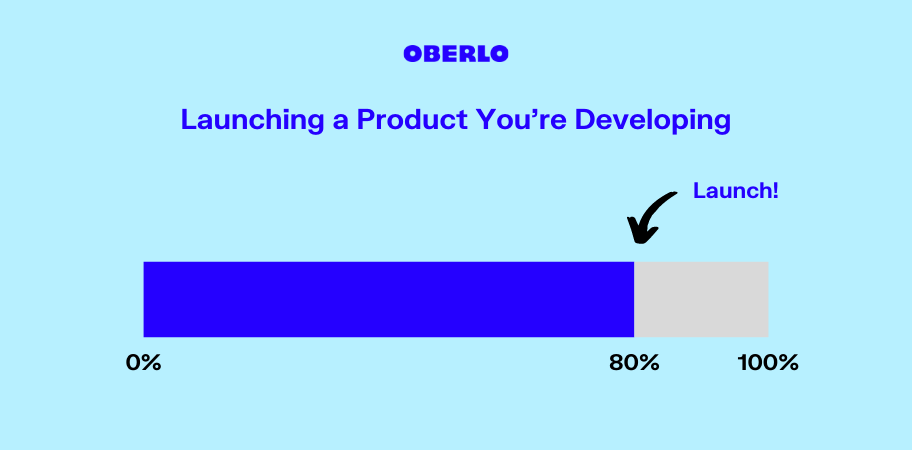
Aleisha:That's fantastic. And I think this is the theme of this episode, it is building relationships and thinking of manufacturers, as you said, like friends and you're not jumping into... You don't wanna be a weirdo and jump into the friend zone really quickly and asking lots of favors of them and discounts and all that sort of stuff, 'cause then you look like a sucky friend. You're like, "I don't wanna be your friend. You're just needy and weird."
So I'm so glad that you've really built that up, and I hope people listening who are wanting to move into from dropshipping to white-labeling to manufacturing really take heed and listen to what you are saying.
So I think it's the key to, as you said, building great relationships, but also then building a quality product that people are gonna go back and buy over and over again and tell their friends about in a good way, not something's falling apart and never go and buy it again.
Kian:Can I just say like, for me, it is the best feeling in the world when you manufacture a product, you have an idea for a product, you get it to sample stage, you manufacture, you order it, and you ship it, and one day you're walking down the street and you see someone wearing your products. It's just like you see it, and it's just the best...
Aleisha:Oh, what a thrill.
Kian:It never gets old. I was developing all these camping and outdoor products for my family business, and I take pride in developing these camping and outdoor backpacks, and I was climbing on top of a hill... We have the most beautiful hills in Scotland.
And I reached the summit and when I was at the summit, I saw another guy at the summit, and he was like had all the gear that I had developed and he was just wearing it, and I was just like... I'm just like...
Aleisha:That's so cool.
Kian:It's an unbelievable feeling. And just to know that that was all designed in my head, then to make it in China, and then somehow this guy has managed to buy it in Scotland and he's standing at the top of the mountain with it, it's just like, "This is the best feeling in the world."
And no matter what category you're in, whether you're in the gym, or home fitness, garden, whatever, and you have an idea and you bring it to life and you see someone purchase it and get value from it, and you witnessed that, it's the best feeling in the world.
Aleisha:I've had a junior version of that experience, Kian. I wrote some wedding planning guides and I had them printed in China. That was my experience in publishing, and it was great, and one of my... I had a podcast called Bridechilla, and one of my listeners saw someone in Chicago on the subway reading one of my books and took a photo of this, and it was a guy of all things.
我想,“噢,我的上帝。”这是这样一个刺激to see it out in the wild, but also that someone had recognized my brand and had taken a photo of it. It was such a thrill. And I'm very small. I'm a small fry, compared to some of the other independent publishers, but I relate to that feeling. I jumped around my lounge room going, "Oh my God." So yeah, it's amazing. It's absolutely amazing.
Kian:Awesome.
Keeping up With Kian
Aleisha:Hey, so if people wanna get in touch, if they want to explore their options when it comes to manufacturing or also just learn from you, as you said, you've got an amazing YouTube channel, you've got a lot of content out there and you're very giving with this information. Where can we get in touch, cyberstalk you in a very pleasant way and hopefully learn from you as well?
Kian:Yeah, for sure. I would love to be cyberstalked. So the best way you can get some valuable information on sourcing is I've got a YouTube channel which is called Sourcing with Kian, and that's a K-I-A-N.
So justSourcing With Kianon YouTube, and I put out about a video a week and I cover lots of different topics about some of the stuff that we talked about like price, MOQ, and using sourcing agents, using online platforms, just everything you need to know about sourcing.
And then I've actually got a Facebook group of the same name,Sourcing With Kian,它的社区。现在发展到4,000 members, which is quite cool.
And anyone can just join, post a question. Like if you've got a question about, "Hey, my manufacturer raised my price, what do I do here?" Just post in the group, and either I or someone from the community answers it within 24 hours, and I do like Facebook Lives and stuff like that in there as well.
And then if you're a little bit more social, I'm on Instagram as well, which is@kian_jg, J for John, G for Golf. Yeah, so @kian_jg. And if you're on Instagram, give me a shoutout, we could connect. Let's chat. Send me a DM and I would like to help out.
Aleisha:Oh, Kian, this has been so good. I'm gonna join all of those groups, I'll be a part of your community in two seconds, and I would love to have you back on the show in the new year if you are open and free 'cause I have so many other questions that have just popped into my brain, but we have run out of time, and I wanna ask you those.
Kian:Anytime. I would love to be back on the show. As we were talking, I was just thinking about so many different other categories within sourcing that we could talk about. We could talk for like three or four hours, so yeah, anytime you need me, just give me a shoutout. I'll be happy to be back on the show.
Aleisha:Then, we will have you back with bells on, 'cause as I said, there are so many things that we want to explore, and also I'm sure people will have lots of questions after listening to this episode.
So if you're listening and you have questions, you can hit us at podcast@oberlo.com. I will bank those questions up for our next conversation with Kian, so you can be ready to answer them.
Also, if you would like to catch up with Kian's amazing walkthrough on Alibaba, all you need to do is head to oberlo.com/podcast. This is episode number 60 of the show. You'll be able to find the blog. I will embed the video in that blog so you can check it out.
And we will happily see you in the new year Kian. Have a safe Christmas period, and I'm really looking forward to chatting with you again soon.
Kian:Thank you so much for having me, Aleisha. It's been a pleasure, and hopefully, see you all soon, and have an amazing end to the year and have an amazing 2021, and I'll see you guys all soon.
Aleisha:Thank you so much.


